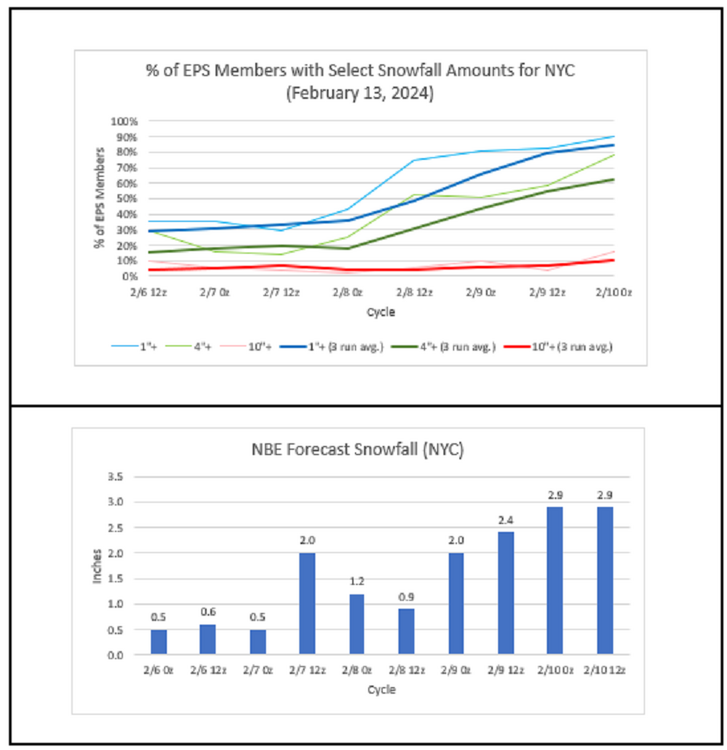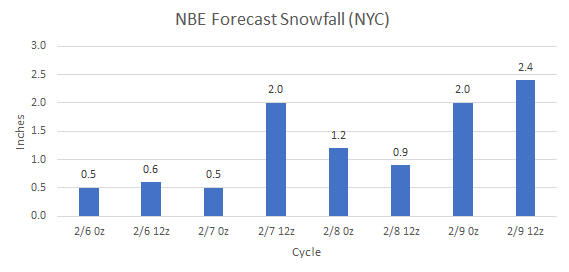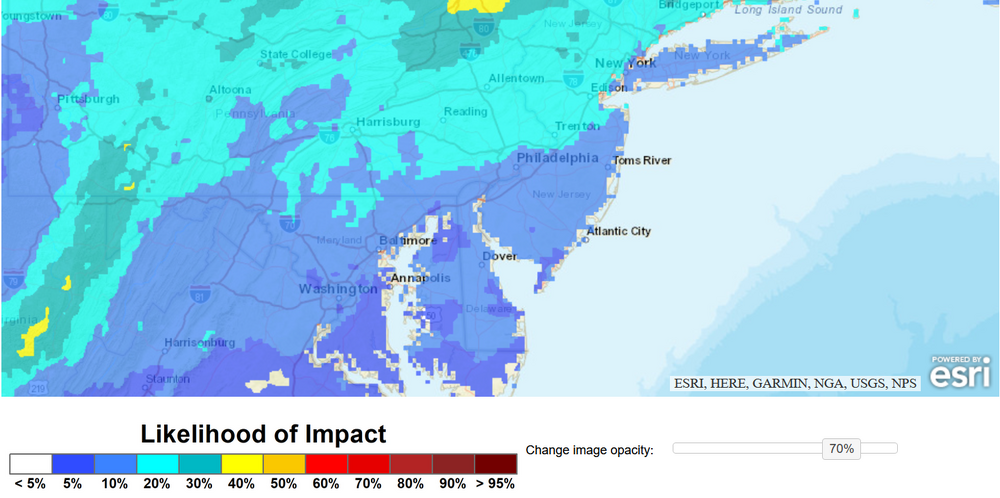-
Posts
22,983 -
Joined
Content Type
Profiles
Blogs
Forums
American Weather
Media Demo
Store
Gallery
Everything posted by donsutherland1
-
After seeing the 0z GFS, GGEM, ICON, and UKMET. I have not seen enough to move away from my initial thinking that this will could be a light accumulation event (after rain) in New York City. By that, I mean 1" to perhaps 3" of snow. Those numbers can be refined either upward or downward following tomorrow's guidance, which could begin to move into better consensus. It is encouraging that there remain some global models with at least a moderate event (after slashing 10:1 maps by 50%) in and around New York City, particularly the higher-scoring GGEM and UKMET. The 2/10 4z NBE also showed 3.0" for NYC, 2.6" for Newark, and 3.5" for White Plains. It remains concerning that much of the storm could occur with NYC's temperature holding at or above 35 degrees (the GFS MOS was not yet available at the time of this post). The elevated temperatures suggest that this will likely be a slushy low ratio snowfall (5:1 or below) that limits accumulations in New York City and Newark. Better rates and accumulations would be likely north and west of those cities.
-

Occasional Thoughts on Climate Change
donsutherland1 replied to donsutherland1's topic in Climate Change
It’s an interesting paper and it confirms “tipping” behavior related to the AMOC. Tipping abruptly from one stable state into another one has been found elsewhere, so I don’t believe it is too surprising that researchers found that the same could hold true for the AMOC. IMO, had they found against tipping, that would have been a more surprising outcome. The full paper is here: https://www.science.org/doi/10.1126/sciadv.adk1189 -
Today was another mild day with temperatures rising into the lower and middle 50s across the region. The temperature will likely peak in the middle or upper 50s in New York City and the 60s in Philadelphia and Washington, DC tomorrow. The generally mild conditions will likely continue into at least the second week of February with only brief interruptions. No Arctic air is likely to reach the area during this time. As a result, the first 10 days of February will likely wind up 5°-7° above normal in New York City. New York City will very likely see a mean temperature of 40.0° or above during the February 1-10 period. Since 1869, there have been 9 prior cases. Five have occurred since 2000 and eight have occurred since 1990: 1952, 1990, 1991, 1999, 2005, 2008, 2012, 2016, and 2020. Seven of those nine years saw less than 10" snowfall for the remainder of the season following February 10th. Only one saw more than 20.0" (22.7", 2005). The least was the trace of snow that fell in 2020. The mean snowfall was 7.2" while the median snowfall was 6.0". In short, were the February 1-10 temperature to average 40.0° or above, that development could be a reinforcing signal for a below to much below normal snowfall season. The second week of February will likely see the evolution toward a sustained colder pattern begin late that week preceded by a storm. That storm could affect the region early next week. There is a possibility that the rain could mix with or end as a period of wet snow or flurries in parts of the region. Parts of the region could pick up a light accumulation of snow. Temperatures will likely remain above freezing throughout most or all of the storm in New York City and adjacent areas. However, there is a degree of uncertainty. Single-digit cold is unlikely in New York City following the pattern change. During February, cases with warm ENSO Region 1+2 anomalies see such lows at 55% of frequency as cold ENSO Region 1+2 cases during El Niño winters. During the second half of February, just 17% of cases with a PDO- saw single-digit cold during El Niño winters. January saw a strongly negative PDO. The ENSO Region 1+2 anomaly was +1.0°C and the Region 3.4 anomaly was +1.8°C for the week centered around January 31. For the past six weeks, the ENSO Region 1+2 anomaly has averaged +0.87°C and the ENSO Region 3.4 anomaly has averaged +1.83°C. A basinwide El Niño event is ongoing. The ongoing El Niño event will continue to fade through much of February. The SOI was -46.54 today. That is the lowest SOI figure since May 24, 2023 when the SOI stood at -64.63. The preliminary Arctic Oscillation (AO) was -1.888 today. On February 7 the MJO was in Phase 6 at an amplitude of 2.220 (RMM). The February 6-adjusted amplitude was 2.271 (RMM). Based on sensitivity analysis applied to the latest guidance, there is an implied 67% probability that New York City will have a warmer than normal February (1991-2020 normal). February will likely finish with a mean temperature near 37.6.° (1.7° above normal).
-
Yet another snowfall opportunity--at least as promised by the GFS--appears to be headed for life support and then its possible demise. A light event still remains plausible, but worries that such an event could also collapse abound. Tweeted calls for the 1961 Kennedy Inaugural storm and 1969 Lindsay storm, extreme 46-day snow maps, and calls for 0-degree readings in New York City, lie in ruins. There are even suggestions that Fall 2023 never really ended. Instead, fall will complete a smooth seasonal transition to Spring 2024 sometime next month. Maybe Taylor Swift's next album will feature "Cruel Winter?" So, what are area snow geese to do? Rely on memories of past storms? Those memories are growing hazier with the passage of time. What about younger members? Maybe the local art gallery or museum can refresh memories or remind one of what a snowy landscape looks like. And maybe Winter 2023-24 can muster up the ingredients needed for a decent snowfall before spring takes hold for good.
-
Technically, the GFS uses a different initialization scheme from the GGEM, ECMWF, and UKMET. The latter three use the 4dVAR scheme, which is the leading one. Initialization differences aside, there could be other reasons why the different models handle things differently. If, for example, the GGEM and ECMWF are diverging, other issues could be involved. Overall, all the models are still searching for the solution and it may take another day or so for there to be good consensus.
-
The ECMWF weeklies are wet from February 26-March 11. The very strongly negative SOI (lowest daily value since May 24, 2023) suggests an active subtropical jet within two weeks or so. So, there may be potential during that period, especially the first half where it looks to be colder than the second half.
-
I think the focus on a light event is warranted until there is more support for something bigger. The GFS is too aggressive. Apparently, a social media account compared the upcoming event to the February 1969 Lindsay Storm (15.3” in NYC and 20.2” at JFK). But that account didn’t tell a key part of the story: the temperature for that storm fell from 34 into the middle 20s. Most of the precipitation fell with readings that were below freezing. That’s not the case this time around. Were there a similar air mass, then we’d be looking at a significant snowfall. One other omission, the 1969 storm was much wetter than what is likely this time: NYC: 1.82” and JFK: 2.49”.
-
Early thoughts: The February 13th storm will very likely be another classic low ratio storm (under 5:1) where 10:1 snowfall maps will overstate the potential snowfall. During the storm, readings will remain well above freezing (possibly 35 or above). At present, the WPC probabalistic winter storm severity index map gives the NYC area about a 20% probability of a minor event. Select part of the WPC probabilistic winter storm severity index map (Minor Impact): The 6z GFS is the most aggressive model. It takes the temperature down to 33 and its soundings are consistent with a wet snow event. Given the marginal air mass involved and differences with the other guidance, including the warmer NBE and warmer 0z GFS MOS, it makes sense to wait for other guidance before buying into the GFS's idea. For now, the idea of a light event seems to be a reasonable course until there is strong and consistent support for something bigger.
-
The warming trend continues. Temperatures rose into the 50s across the region today. Even warmer temperatures lie ahead. The temperature will likely peak in the middle or upper 50s in New York City and into the 60s in Philadelphia and Washington, DC on Saturday. The generally mild conditions will likely continue into at least the second week of February with only brief interruptions. No Arctic air is likely to reach the area during this time. As a result, the first 10 days of February will likely wind up 5°-7° above normal in New York City. New York City will very likely see a mean temperature of 40.0° or above during the February 1-10 period. Since 1869, there have been 9 prior cases. Five have occurred since 2000 and eight have occurred since 1990: 1952, 1990, 1991, 1999, 2005, 2008, 2012, 2016, and 2020. Seven of those nine years saw less than 10" snowfall for the remainder of the season following February 10th. Only one saw more than 20.0" (22.7", 2005). The least was the trace of snow that fell in 2020. The mean snowfall was 7.2" while the median snowfall was 6.0". In short, were the February 1-10 temperature to average 40.0° or above, that development could be a reinforcing signal for a below to much below normal snowfall season. The second week of February will likely see the evolution toward a sustained colder pattern begin late that week preceded by a storm. That storm could affect the region early next week. There is a possibility that the rain could mix with or end as a period of wet snow or flurries in parts of the region. Temperatures will likely remain above freezing throughout the duration of the storm. Single-digit cold is unlikely in New York City following the pattern change. During February, cases with warm ENSO Region 1+2 anomalies see such lows at 55% of frequency as cold ENSO Region 1+2 cases during El Niño winters. During the second half of February, just 17% of cases with a PDO- saw single-digit cold during El Niño winters. January saw a strongly negative PDO. The ENSO Region 1+2 anomaly was +1.0°C and the Region 3.4 anomaly was +1.8°C for the week centered around January 31. For the past six weeks, the ENSO Region 1+2 anomaly has averaged +0.87°C and the ENSO Region 3.4 anomaly has averaged +1.83°C. A basinwide El Niño event is ongoing. The ongoing El Niño event will continue to fade through much of February. The SOI was -32.23 today. The preliminary Arctic Oscillation (AO) was -1.565 today. On February 6 the MJO was in Phase 7 at an amplitude of 2.271 (RMM). The February 5-adjusted amplitude was 2.080 (RMM). Based on sensitivity analysis applied to the latest guidance, there is an implied 67% probability that New York City will have a warmer than normal February (1991-2020 normal). February will likely finish with a mean temperature near 37.7.° (1.8° above normal).
-
I don't know enough about the war's impact to address that issue. There had been a general decline in average winter precipitation from the late 1930s bottoming out at the end of the 1960s.








